
Coming Together to Advance ALPA Priorities at the Air Safety Forum
Air Safety Organization Private Meetings
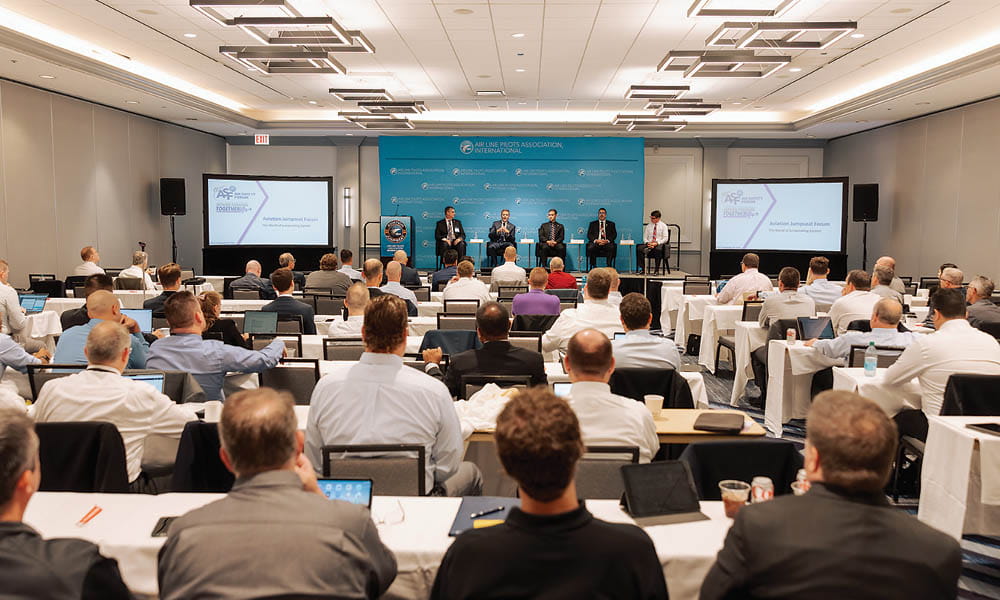
From September 8–10, 2025, the various councils, committees, and groups within ALPA’s Air Safety Organization (ASO) four pillars of Aviation Safety, Aviation Security, Aviation Jumpseat, and Pilot Assistance gathered at the 69th Air Safety Forum in Chicago, Ill. Joined by industry and government experts, ASO pilot volunteers shared current ALPA priorities, reviewed accomplishments, and set the course for future successes.
“ALPA’s volunteers are what power our Association, and a prime example of this is on display at the Air Safety Forum,” said Capt. Wendy Morse, ALPA’s first vice president and national safety coordinator. “With hundreds of pilot subject-matter experts coming together to continue their work in making the safest form of transportation even safer and more secure, it’s a testament to the power of unions and a clear demonstration of our dedication to the industry.”
Security Council and Forum
The Aviation Security Group held both a Security Council meeting and a Security Forum, gathering over two days to discuss current work and priorities.
Capt. Kurt Schuster (JetBlue) opened the Security Council meeting—his first as council chair—on Monday morning. He noted that the Security Group is in a time of transition, as a few longtime subject-matter experts are retiring or departing, and told attendees, “We need to carry the torch that they so brightly lit.”
The council began with a roundtable briefing from the various chairs of ALPA’s Master Executive Council (MEC) Security Committees—what they’re seeing, what they need assistance with, and solutions they’ve found that could benefit others. Capt. Scott Robertson (Air Canada), the director of Security, Canada, provided an update on Canadian issues.
Over the course of the day, the group discussed topics including Known Crewmember® (KCM), GPS jamming and spoofing, flight crew security, international travel, lasers, cargo security, the Canadian Air Transport Security Authority, and more.
The Security Forum opened on Tuesday, led by Capt. Wolfgang Koch (Delta), the ASO Aviation Security chair. Attendees heard presentations on fentanyl and how it could potentially be weaponized, along with ongoing concerns regarding UAS and small UAS—those weighing 55 pounds or less and typically available for purchase by the general public.
The Security Group has coordinated with two companies, Everbridge and Factal, that provide security apps—Everbridge for Security Committee volunteers and Factal for ALPA’s pilot group members. The forum heard from company representatives about the respective uses and benefits of each app. A Delta Air Lines senior corporate counsel also spoke about legal issues, such as with disruptive passengers, within the security realm.
The Security Forum closed with updates from subject-matter experts in the group’s priority areas, including threatened airspace, law enforcement, Canada, cargo, hotels, UAS, and the Federal Flight Deck Officer (FFDO) program.
Jumpseat Council and Forum
Much of the agenda at this year’s Jumpseat Forum featured a security-related theme. Other conference segments underscored the status of international jumpseat efforts, current group resources like the jumpseat finder in the ALPA app, and the importance of adhering to outlined protocols when using this special airline pilot privilege.
“Keep up the good work,” said Capt. A.J. Berlotti (Alaska), the Aviation Jumpseat chair, who thanked the many jumpseat representatives for their participation, including two pilots from Porter Airlines, ALPA’s newest pilot group. Berlotti also provided a special tribute to longtime pilot volunteer Capt. Robert Spadea (United), who’s served for decades in a variety of ALPA Jumpseat Group capacities.
A highlight of the event was a keynote address from John Pistole, a former head of the U.S. Transportation Security Administration, who provided an overview of airport security programs like KCM and its replacement, Crewmember Access Point; FFDO and the Federal Air Marshal Service; and other risk-based security initiatives. He also discussed terrorist attack efforts from the last 25 years and some of the new challenges currently confronting law enforcement analysts.
FBI special agents and intelligence analysts talked about programs designed to build partnerships with aviation security stakeholders, bureau-provided support available at U.S. airports, and the evidence-response effort assigned to the United Airlines Flight 93 accident site in Shanksville, Pa., following the 9/11 terrorist attacks. Others led discussions about the signs to look for in narcotics and human-trafficking activities and how to anticipate and plan for active-shooter scenarios.
In addition, a panel discussion examined ongoing efforts to coordinate with the pilots of international airlines and their carriers to establish an international jumpseat system.
Prior to this event, members of ALPA’s Jumpseat Council—the MEC Jumpseat Committee chairs from each of ALPA’s 43 pilot groups—convened for a brief session to discuss priorities and new business.
Safety Council
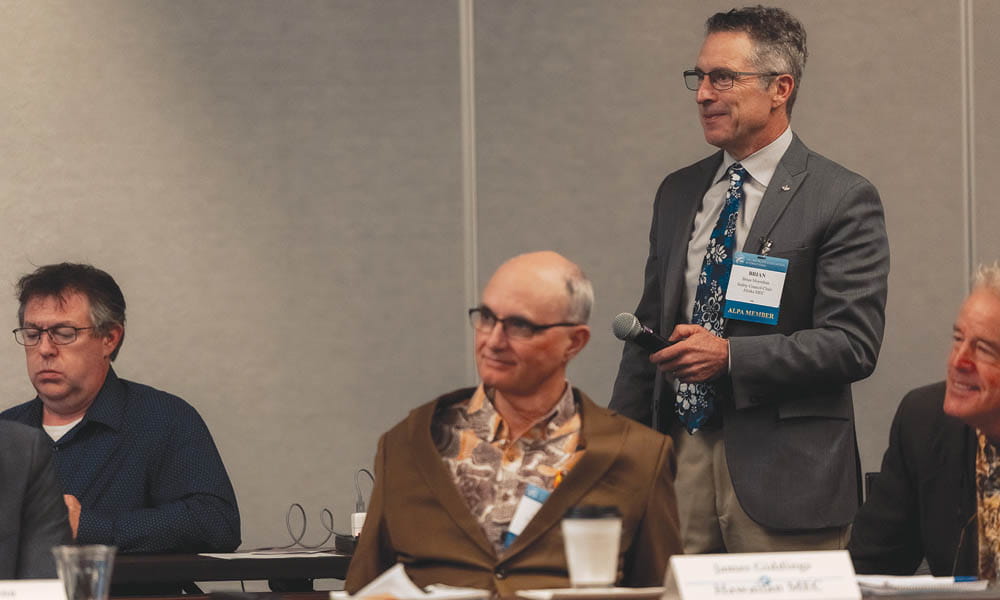
Capt. Brian Moynihan (Alaska), ALPA’s Safety Council chair, led the council’s meeting on Tuesday. The agenda reflected a broad range of current and emerging safety concerns, underscoring the council’s role in sharing expertise and best practices across the Association.
Capt. Mike Kendrick (JetBlue), his pilot group’s Central Air Safety Committee chair, along with F/O Anna-Maria Scorsone (JetBlue), ALPA’s Health and Environmental Working Group (HEWG) chair, opened with a briefing on fume events, followed later by a joint presentation with Capt. Doug Marchese (JetBlue), ALPA’s Flight Time/Duty Time Committee chair, on fatigue. Kendrick also examined the growing use of artificial intelligence (AI) to study fatigue and its operational implications. Other highlights included a fire-containment presentation and a briefing on “Big 5” exclusions in the Aviation Safety Action Program (ASAP), with Capt. Kevin Slovinski (Spirit), ALPA’s Safety Management Systems (SMS) Group chair and Safety Information Analysis Program (SIAP) director, focusing on alcohol-related reporting.
Several presenters explored the increasing role of AI in aviation safety. F/O James Norman (Delta), ALPA’s SMS Group vice chair, examined broader safety applications, while he and Capt. Collin Willson (Delta), a member of his pilot group’s ASAP Event Review Committee, discussed the possible implications of AI within ASAP. The use of AI, as well as its opportunities and risks, emerged as a recurring theme throughout the session.
Council members also heard from representatives from the MITRE Corporation and the FAA on safety data and the work of the Commercial Aviation Safety Team. Moynihan and an Alaska Airlines dispatcher provided an update on their participation in Alaska’s Dispatcher/Pilot Working Group, emphasizing collaborative approaches to operational safety.
The agenda also included discussions regarding remote operations and a legislative affairs briefing.
Joint Safety Council, Training Council, and Human Factors & Training Group Meeting
Moynihan; Capt. Randy Symanski (Spirit), ALPA’s Training Council chair; and Capt. Todd Lisak (JetBlue), ALPA’s Human Factors & Training (HFT) Group chair, welcomed 116 participants from across ALPA’s membership to the joint Safety Council, Training Council, and HFT Group meeting on Monday.
Capt. Steve Jangelis (Delta), ALPA’s Aviation Safety Group chair, emphasized the vital role of the councils as subject-matter experts who shape safety culture across the industry. He pointed to air traffic control modernization, secondary flight deck barriers, and fatigue as key issues demanding continued pilot engagement with regulators and airline management. The session also featured updates from ALPA’s various technical groups on topics discussed at their meetings.
Lisak spoke about human factors as a cross-disciplinary effort, spanning fatigue, turbulence training, and new device technologies. He encouraged greater pilot participation to support this work.
Joint Training Council and HFT Group Meeting
Symanski and Lisak welcomed 56 participants to the joint meeting of their two groups on Tuesday.
The agenda featured a range of training and human factors topics. Capt. Doug Branch (Alaska), his pilot group’s Training Committee chair; Capt. Bryan Burks (Alaska), a member of his pilot group’s Human Factors & Training Committee; and Capt. Logan Shamoon (Envoy Air), his pilot group’s Training Committee chair, briefed attendees on emerging virtual-reality and extended-reality training devices and the potential of these devices to reduce infrastructure and cost requirements while raising important questions about fidelity, data usage, and instructor oversight.
An update was given on recent developments in human factors, including the Association’s new Human Factors Handbook, which is designed to assist MECs in standing up their own Human Factors Committees and developing pilot education initiatives.
Lisak briefed participants on the FAA/industry FAR Part 141 modernization initiative, highlighting ALPA’s priorities of maintaining high training standards, preserving flight-hour requirements, and ensuring that primary training continues in actual aircraft operating in the national airspace system. Attendees also engaged in a robust discussion about concerns that potential regulatory changes could reduce training quality.
The meeting concluded with pilot group updates, giving attendees the opportunity to share current training issues and solutions from across the airline industry.
Canada Breakout
Capt. Jean-Claude Patchell (Jazz Aviation), ALPA’s Canadian Aviation Safety coordinator, welcomed speakers and attendees to the breakout session.
Capt. Tim Perry, ALPA Canada president, discussed the work being done in Canada to advocate for the interests of Canadian pilots while prioritizing safety. He emphasized the need to initiate conversations about mental health and enhance training and licensing requirements and stressed the importance of uniting against reduced-crew operations (RCO). Perry also highlighted the ongoing collaboration with Transport Canada to improve fatigue regulations.
Morse spoke about ongoing ASO work and topics of mutual importance to Canadian and other North American airline pilots.
ALPA staff reviewed Part II of the Canada Labour Code (CLC) and areas of interest to pilots, such as the “Right to Refuse Dangerous Work,” “Internal Complaint Resolution Process,” and “Policy and Workplace Health and Safety Committee” and the differences between Canadian aviation regulations Safety Management System (operational safety) and CLC Part II (occupational health and safety). In addition, they discussed the Association’s occupational health and safety initiatives, including efforts in the areas of cabin air quality, cabin temperature, and cosmic radiation through ALPA’s HEWG.
Attendees heard from a Transportation Safety Board (TSB) of Canada Regional Operations/Air Investigations manager regarding organizational changes within the agency. He also announced that the TSB Watchlist, which will be published on a new three-year cycle, would be released in early fall. Along with new recommendations, runway incursions, runway overruns, and Safety Management Systems remain on the list.
Capt. Emile Lacourciere (Air Transat), ALPA Canada’s Flight Time/Duty Time Task Force chair, provided an update on recent work, including addressing a global exemption for Fatigue and Risk Management Systems (FRMS) that Transport Canada proposed to the group in May. The proposed exemption threatens to increase pilot fatigue by exempting specific core pieces of the fatigue regulations without providing adequate mitigating strategies.
Joint Cargo Committee and Dangerous Goods Meeting
Capt. Jim Perry (FedEx Express), ALPA’s Cargo Committee chair, opened the meeting by reminding the group that the pursuit of safety has no boundaries and encouraged open dialogue throughout the day.
He highlighted that history shows recurring accidents and organizational failures stem from cultural blind spots, human variability, and systemic weaknesses. Effective safety organizations must move beyond reactive learning and instead adopt continuous learning systems, early error detection, and resilient safety cultures.
Perry noted that ALPA’s Cargo Committee adds value by advocating for pilot input in safety risk assessments (SRAs); strengthening safety-assurance programs like ASAP, Flight Operational Quality Assurance (FOQA), and Line Operations Safety Assessment; and promoting a strong safety culture across airlines and industry partners. The remainder of the day included a briefing from the NTSB, a discussion on FRMS, cargo security updates, and lessons learned from the FedEx Flight 1376 accident.
Capt. Dave Schlichting (Fed-Ex), the newly appointed ALPA Dangerous Goods program director, led the dangerous goods discussions during the second day of the joint meeting. Much of these discussions focused on dangerous goods that are allowed to be carried aboard aircraft by passengers and crew. Several recent incidents regarding personal electronic devices were highlighted, and Schlichting emphasized an increased awareness of the hazard posed by lithium-battery-powered mobility aids.
In addition to ALPA volunteers and government participants, this year’s discussions included airline company representatives. Schlichting emphasized that representatives from the Association, airlines, and regulatory agencies are all part of one team to help enhance the safe carriage of dangerous goods by air. The inclusion, and perspective, of these representatives was seen as a positive contribution by the members of the group.
Reduced Crew Operations Committee
Capt. Jason Ambrosi, ALPA’s president, opened Tuesday’s RCO Committee meeting by sharing industry updates on RCO, extended minimum crew operations (eMCO), and single-pilot operations (SiPO). “Even though it seems the European Union Aviation Safety Agency [EASA] has backed away from RCO and eMCO topics for now,” he said, “ALPA will never accept anything but two highly trained and well rested pilots on the flight deck.”
Capt. Bill Secord (FedEx), the Association’s RCO Committee chair, briefed attendees on what ALPA is proactively doing to combat RCO, SiPO, and eMCO within the United States and Canada. He spoke about EASA’s safety risk assessment for eMCO/SiPO, explaining that the risk assessment revealed that eMCO/SiPO doesn’t provide the same equivalent level of safety as two pilots on the flight deck.
Capt. Chris Sidor (United), ALPA’s Aircraft Design & Operations (ADO) Group chair, discussed AI as well as vehicle design certification requirements. The day ended with ALPA’s Communications Department showcasing the “Safety Starts with 2” campaign, including sharing a new Safety Starts with 2 video.
Remote Operations Committee
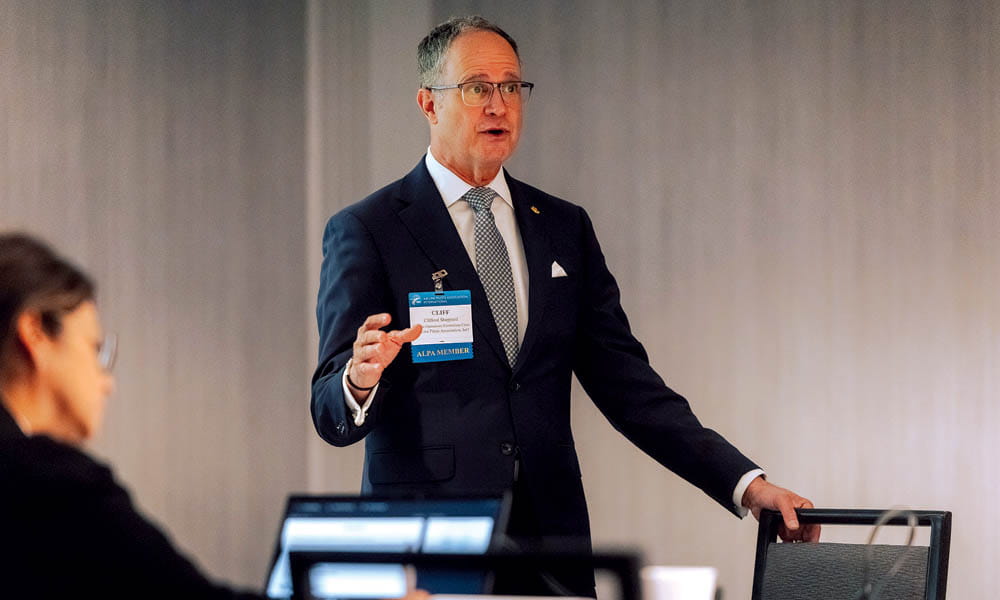
Capt. Cliff Sheppard (United), ALPA’s newly appointed Remote Operations Committee chair, welcomed speakers and attendees to the meeting. He provided a brief history of the committee and thanked Capt. Peter Black (Canadian North, Ret.) for his work and dedication as the previous chair.
Discussion focused on the selection of viable alternate airports in northern and remote areas worldwide. The group spoke about the lack of available services at designated alternate airports and the safety considerations associated with isolated regions. The committee highlighted some of the many challenges that pilots encounter when responding to a situation where a landing is necessary despite marginal and potentially unverified airport services.
Patchell provided an update on approach controlling temperature (ACT), which is Canada’s version of the FAA’s cold temperature airports. In Canada, only two operators, Air Canada and WestJet, have permission to use a nonstandard cold temperature correction method, and Transport Canada isn’t yet prepared to expand ACT. The group was also updated on the status of aircraft rescue and firefighting (ARFF). Transport Canada plans to meet International Civil Aviation Organization (ICAO) standards by including “rescue” in the firefighters’ mandate and reducing response times.
Aeromedical Meeting
ALPA’s Aeromedical Committee began the week providing training to 16 pilot volunteers from seven airlines. Training included an overview of the group’s structure, focus, resources, and responsibilities as well as a review of confidentiality and its limitations.
ALPA pilot group Aeromedical Committee chairs later held a meeting, led by F/O Rick Mahoney (Delta), the Association’s Aeromedical Committee chair, and discussed such topics as support needs for pilot groups, networking, and an FAA survey on noncompliance.
On Tuesday, attendees heard about proactive cardiac health practices and fatigue management and also learned more about related ALPA resources such as the Human Intervention Motivation Study (HIMS) and Pilot Peer Support (PPS). In addition to FAA Federal Air Surgeon Dr. Susan Northrup’s appearance at Wednesday’s “Meet the Doctors” panel, she spent time with the Aeromedical Committee participating in one-on-one conversations about FAA initiatives.
Critical Incident Response Program Chairs Meeting
Chairs of MEC Critical Incident Response Programs (CIRP) met Monday and Tuesday, led by Capt. John McFadden (United), ALPA’s CIRP chair.
Representatives from the Allied Pilots Association, the Southwest Airlines Pilots Association, and the National Air Traffic Controllers Association also took part in the meeting. Each gave a presentation about their structure and processes, sharing information among the four unions.
The meeting also included a roundtable discussion that addressed standardized responses to some of the more common events pilots face, followed by a conversation regarding future plans for the program.
Pilot Peer Support Chairs Meeting
F/O Carrie Braun (JetBlue), ALPA’s PPS chair, welcomed pilot group PPS chairs to the Tuesday meeting. She provided a recap of the Association’s “Are You in the Green?” mental-health campaign, and the group then heard updates from the FAA regarding aeromedical issues and seeking counseling.
A MITRE Corporation representative briefed attendees on a study being done by an aeromedical safety coalition related to PPS programs as a way to assist in managing aviation safety risks.
The group also discussed expectations and the need for engagement with chairs, volunteers, and stakeholders, as well as volunteer recruitment.
Joint CIRP and PPS Meeting
Following the meetings of both groups’ chairs, the two groups met together on Tuesday afternoon for a combined discussion. The conversation focused on recent accidents and incidents and support for Association members in their time of need.
Pilot Assistance Canada Chairs Meeting
Capt. Jacques Gendron (Air Transat), the Pilot Assistance Canada chair, welcomed pilot group chairs and highlighted the tremendous work done in Canada over the past year.
Coordinators from PPS, CIRP, Aeromedical, and Professional Standards provided reports focusing on their respective areas. Attendees heard a presentation on pilot resilience and an update on the ALPA Canada Pilot Recovery Program. They also discussed the Canadian Aeromedical Support Program.
Health and Environmental Working Group Meeting
Scorsone and HEWG members met to review the first video module for the Cabin Air Quality/Fume Event training being developed for ALPA members. The group provided feedback to the Association’s Communications Department team members as they work to finalize the training program.
In addition, they discussed topics surrounding radiation, examined third-quarter FAA Service Difficulty Report fume event data for ALPA pilot groups, and reviewed relevant published articles related to commercial aircraft engine oil decomposition.
The group’s work supports three current government initiatives—one by the National Academies of Science, Engineering, and Medicine study on assessing radiation exposure, health outcomes and mitigation strategies for flightcrew members; the second study on aircraft cabin temperatures; and the third study on overall aircraft cabin air quality.
Professional Standards Training and Meeting
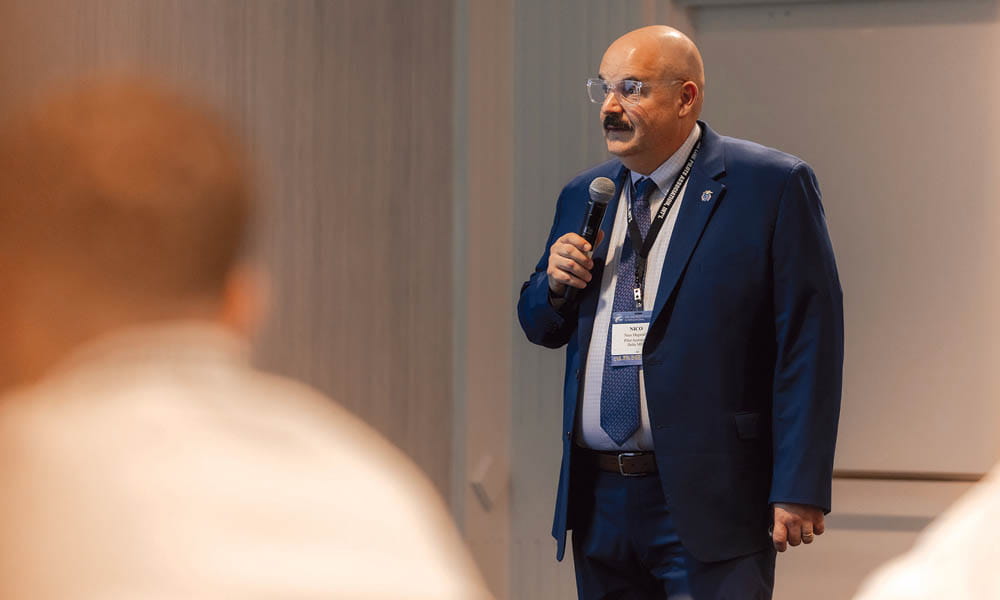
The Professional Standards Group and Capt. Tom Letson (Delta), the group’s chair, held two events. The first was the launch of the Professional Standards 201 training session to provide advanced training for volunteers. The training highlighted listening and leadership skills and addressed volunteer burnout. It also covered available resources, escalation protocols, and working complicated cases. In addition, the training included a legal discussion with a member of ALPA’s Legal Department.
The chairs of each MEC Professional Standards Committee also gathered for discussion. Attendees were given briefings from the various subcommittees, received a training update, and heard from ALPA’s Legal Department. They also talked about hot topics within the MECs and common issues many are seeing and discussed the logistics of the 2026 Professional Standards Forum and potential speakers.
Chief Accident Investigator Refresher
Capt. Jeff Perin (Spirit), ALPA’s Accident Investigation Board (AIB) chair, welcomed attendees and then discussed the Association’s participation in recent accident investigations. A representative from the NTSB gave a presentation on the process of investigative hearings and provided an update on the previous turbulence study that the board conducted. He also discussed upcoming changes to NTSB policy on the redaction of flightcrew member personal information.
A manager from the TSB Western Region spoke about the TSB Watchlist and the agency’s process for releasing safety recommendations and provided updates on current investigations involving ALPA pilot groups.
Baby B’Air also gave a short presentation on the company’s baby harness.
Accident Analysis & Prevention Meeting
Capt. Jeff Mee (United), ALPA’s Accident Analysis & Prevention (AAP) Group chair, welcomed participants to the meeting. He outlined the subgroups under AAP and provided an update on the work of the Investigative Technologies Aviation Rulemaking Committee, which he cochaired. Perin also briefed the group on AIB efforts and highlighted the Association’s participation in current investigations. In addition, Schlichting updated the group on current dangerous goods issues, discussed the dangers of lithium-battery-powered mobility aids, and explained challenges to electronic Notifications to Captain.
Slovinski briefed attendees on current ASAP- and FOQA-related programs and on the work that the Association’s SIAP has done throughout the year. The group also heard from an International Federation of Air Line Pilots’ Associations (IFALPA) representative about the organization’s current projects, including IFALPA’s turbulence paper, the upcoming ICAO Air Navigation Commission paper review, and IFALPA accident investigator accreditation.
Air Traffic Services Meeting
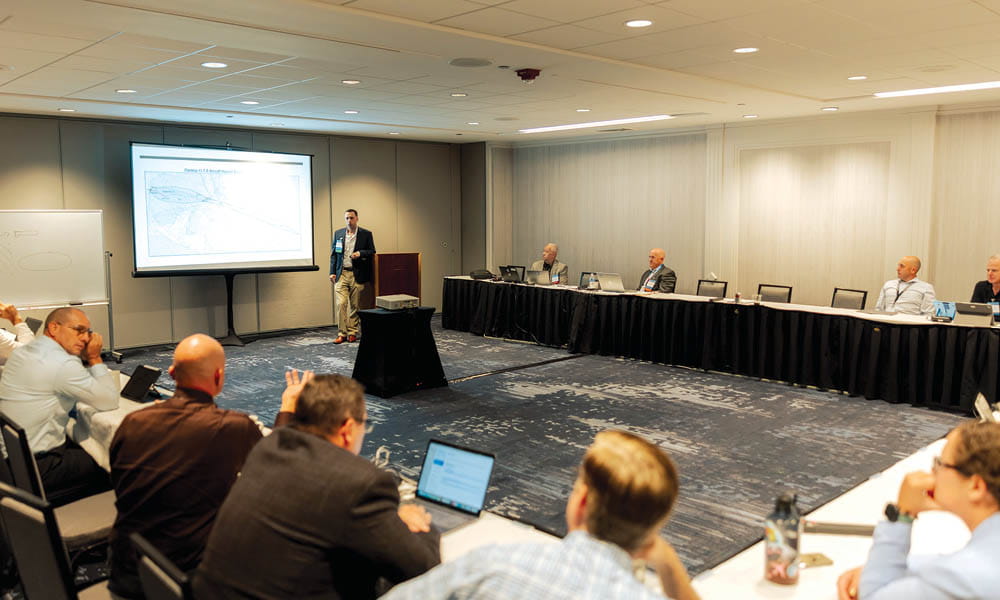
Capt. Craig Boxrucker (Alaska), ALPA’s newly appointed Air Traffic Services (ATS) Group chair, opened the meeting, which focused on the challenges of modernizing U.S. and Canadian airspace systems, airspace integration of new entrants, global harmonization of air traffic operations, and new technology to improve Air Traffic Management (ATM).
Presentations were given on airspace modernization, commercial space operations, industry collaboration and industry priorities, and the FAA Reauthorization Act of 2024, along with updates on various FAA working groups.
Attendees also received project updates from ATS pilot volunteers and ALPA staff engineers and met jointly with ADO and Airport & Ground Environment (AGE) Group volunteers to discuss common issues, including providing real-time weather information to the flight deck, IFALPA, ICAO, and potential challenges with implementing a modernized ATM system.
Aircraft Design and Operations Meeting
Sidor kicked off a busy ADO meeting with a welcome to attendees and thanks for their hard work.
Included in the first day were a review of the Master Minimum Equipment List (MMEL) secondary barrier policy letter that the group worked on; a presentation from VisionSafe on a system to create a smoke-free “bubble” for pilots; information from the RTCA special committees that are developing standards for takeoff performance and alerting, radar altimeters, airborne weather radar, and UAS; and an update on AI and machine learning.
The fight against RCO took center stage on day two, with a review of research on SRAs, fatigue management, and flight training. The group also discussed the use of AI-enabled tools to assess runway hot spots and braking action and heard updates from Boeing and Airbus.
Airport & Ground Environment Meeting
Capt. Jeff Sedin (United), the AGE Group chair, started the meeting by expressing his appreciation for the members’ dedicated work and commitment to maintaining safe operations at airports. The meeting focused on the challenges and concerns regarding pilots’ daily operations at airports in the United States and Canada.
Discussion centered on a few central topics: land and hold short operations at Harry Reid International Airport in Las Vegas, Nev.; ARFF foam transition; the Aircraft Ground Deicing Committee’s activities; and airport winter operation concerns. The group also received presentations on ongoing construction, IFALPA, wildlife management, and a joint ASO technical committee briefing on aircraft braking reports and available technology from Aviation Safety Technologies.
The AGE private-day sessions wrapped up with group priorities and goals for the upcoming year.
Safety Information Analysis Program Meeting
Slovinski welcomed attendees, reviewed the agenda, and updated the group on work conducted during the past year. He noted that SIAP had completed more than 100 calls and eight property visits. F/O Chris Arnold (United), ALPA’s Pilot Assistance Group vice chair, gave a presentation on PPS program resources available to pilots, while Willson and Norman gave a briefing on Delta Air Lines’ use of AI to categorize ASAP reports. Attendees also heard about current FOQA issues and an update on Crosstalk program initiatives at different properties.
Safety Management Systems Breakout Session

Slovinski and Norman provided attendees several updates on the work of the SMS Group.
Slovinski also discussed the group’s progress on the Association’s first SMS and ASO manuals, including an update on recent SRAs conducted by the SMS Group pertaining to safety issues identified by ASO leaders.
Attendees also reviewed best practices to enable ALPA pilots to participate in their SMS activities and ensure that Association members have a seat at the table when airlines conduct SRAs. They discussed strategies to highlight the contributions of ALPA pilots to an airline’s SMS. In addition, Norman facilitated a workshop focusing on how to conduct quality risk assessments and how to prepare volunteers to participate in SRAs.
Guest speakers included two representatives from IFALPA’s Safety Management Working Group, who provided a briefing on the SMS standards work ICAO is conducting.
Air Safety Organization Town Hall
After convening separately for two days, members of all four pillars of ALPA’s Air Safety Organization (ASO) convened together on Wednesday morning for a town hall meeting before opening the public days of Air Safety Forum that afternoon.
Kicking off the town hall, Capt. Wendy Morse, ALPA first vice president and national safety coordinator, led a panel composed of ASO group chairs Capt. Steve Jangelis (Delta), Aviation Safety; Capt. Wolfgang Koch (Delta), Aviation Security; Capt. Travis Ludwig (United), Pilot Assistance; and Capt. A.J. Berlotti (Alaska), Aviation Jumpseat. Each chair provided updates on their areas of focus. The panel discussed a range of topics, including recent legislation addressing pilot mental health, anticipated changes to the Known Crewmember® program, progress on an international jumpseating framework, and ALPA’s response to the PSA Flight 5342 and Endeavor Flight Air 4819 accidents.
F/O Stacey Jackson (WestJet), ALPA’s ASO Training Programs coordinator, provided an overview of ASO training courses—what they are, their focus, and what’s available for each master executive council and its pilots. She also highlighted upcoming new programs, including a Chief Accident Investigator workshop, Safety Management Systems workshop, and Professional Standards 201 training.
The final event of the morning was a panel discussion titled “Meet the Doctors,” which examined the U.S. medical certification process and the positive improvements the FAA Office of Aerospace Medicine has instituted to promote greater efficiency, fairness, and transparency. Moderated by F/O Rick Mahoney (Delta), ALPA’s Aeromedical Committee chair, panelists included FAA Federal Air Surgeon Dr. Susan Northrup and ALPA Aeromedical Advisor Dr. Quay Snyder. Northrup reported that her office processes about 450,000 medical applications per year, with a 94.5 percent approval rate, and that it continues to revisit policies and practices to help those who’ve experienced physical and mental-health challenges return to the airline flight deck when it’s safe to do so.












